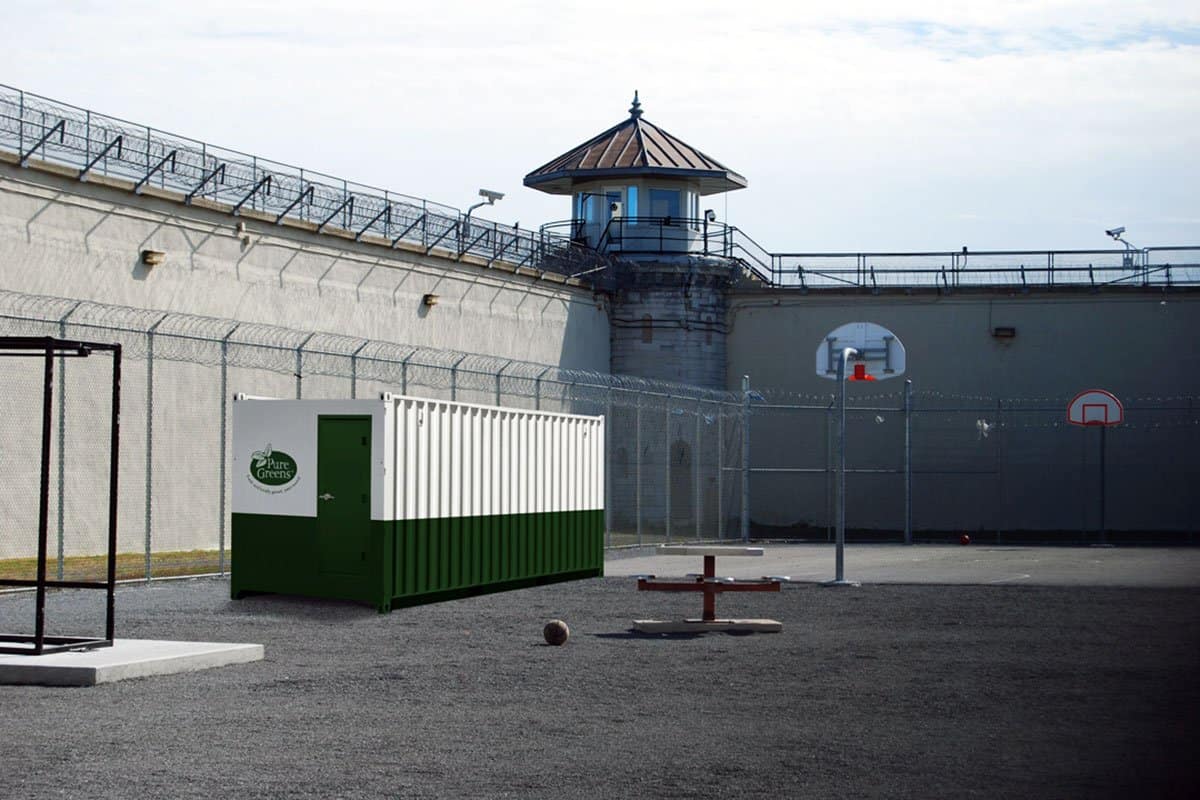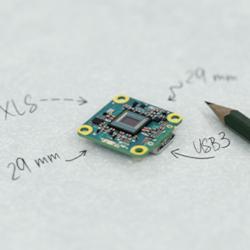Hydroponic container farms offer a unique solution by providing inmates hands-on training in an engaging and therapeutic environment. This blog explores how this sustainable and efficient farming technique can contribute to breaking the cycle of recidivism.
How Container Farming Benefits Correctional Facilities
Article from | Pure Greens Container Farms
Container farming is an innovative farming method with tremendous potential for addressing various challenges, including reducing recidivism rates in correctional facilities. Recidivism, the tendency of individuals to relapse into criminal behavior after release, is a significant issue faced by correctional systems worldwide.
Correctional facilities face numerous obstacles in their efforts to reduce recidivism rates, like limited vocational training options and a lack of effective rehabilitation programs. However, hydroponic container farms offer a unique solution by providing inmates hands-on training in an engaging and therapeutic environment. This blog explores how this sustainable and efficient farming technique can contribute to breaking the cycle of recidivism.

By embracing hydroponics, correctional facilities can empower inmates, equip them with valuable skills, and create pathways to a brighter future beyond incarceration.
Understanding Recidivism and Its Challenges
Recidivism, the reoccurrence of criminal behavior among individuals who have been previously incarcerated, poses significant challenges for correctional facilities and society as a whole. Understanding the complexities of recidivism is crucial to address the root causes and develop practical solutions.
Recidivism affects the individuals involved and has far-reaching consequences for communities. It perpetuates a cycle of crime, strains resources, and undermines efforts to promote public safety and rehabilitation. Factors contributing to recidivism include:
- Limited employment opportunities.
- Lack of education and vocational training.
- Substance abuse issues.
- Inadequate social support networks.
Correctional facilities face considerable challenges in reducing recidivism rates. Many struggle to provide comprehensive rehabilitation programs and opportunities for skill development. Traditional approaches often fail to address the underlying issues contributing to criminal behavior, leaving individuals ill-equipped to reintegrate into society upon release.
Correctional systems must prioritize vocational training and skill development programs to break this cycle. Equipping inmates with tangible skills, such as those offered by hydroponic container farms, can increase their chances of successful reintegration and reduce the likelihood of returning to criminal activity. Vocational training provides practical knowledge and instills a sense of purpose, self-worth, and hope for a better future.
Introduction to Container Farms
To understand how container farming can reduce recidivism rates in correctional facilities, we must familiarize ourselves with hydroponics and its unique advantages over traditional farming methods.
Hydroponics is a soil-less farming technique that involves growing plants in nutrient-rich water solutions, with their roots supported by inert mediums like perlite or coco coir. This method eliminates the need for soil, relying instead on a controlled environment where essential nutrients, pH levels, and lighting conditions can be carefully regulated.
Hydroponic container farms offer a practical and scalable solution for correctional facilities. You can fit these self-contained systems in limited spaces, making them ideal for correctional institutions with limited land availability. They utilize vertical farming techniques, maximizing productivity by stacking multiple layers of plants in a compact setup.
One of the primary advantages of hydroponic container farms is their water efficiency. They consume up to 90% less water than traditional soil-based farming methods. This is especially crucial in regions where water scarcity is a concern, as it allows for sustainable cultivation and conservation of this precious resource.
Furthermore, hydroponics enables year-round cultivation, independent of climate and seasonal variations. This consistent production ensures a reliable supply of fresh produce and provides inmates with a continuous learning experience and engagement throughout the year.
In addition to the practical benefits, hydroponic container farms can potentially create vocational training and employment opportunities for inmates. By learning the principles and techniques of hydroponic farming, inmates can acquire valuable skills transferable to the larger agricultural industry, horticulture, or even entrepreneurship.
Benefits of Container Farming for Correctional Facilities
Container farming offers a range of benefits for correctional facilities to reduce recidivism rates and promote rehabilitation among inmates. Here are a few of the advantages:
Therapeutic and Rehabilitative Effects
Working with plants in a controlled environment has positively impacted mental well-being. Hydroponic container farms provide inmates purpose, responsibility, and connection to nature. Nurturing and tending to plants also can be therapeutic, promoting stress reduction, emotional healing, and improved self-esteem.
Hands-On Vocational Training
Hydroponic farming programs in correctional facilities offer practical, job-specific training that equips inmates with valuable skills. From understanding hydroponic systems to plant propagation, nutrient management, and pest control, inmates gain expertise in a niche area of agriculture. Moreover, this vocational training can increase their employability upon release, providing a pathway to stable employment and reducing the likelihood of reoffending.
Transferable Skills
Hydroponic farming requires knowledge and competencies that go beyond agriculture. Inmates learn critical skills such as problem-solving, teamwork, time management, and attention to detail. These transferable skills can be applied to various industries, empowering inmates to explore new career opportunities and adapt to different work environments.
Sense of Responsibility and Accomplishment
Hydroponic farming programs instill a sense of responsibility and accomplishment among inmates. As they witness the growth and progress of their plants, they develop a sense of pride in their work. This feeling of achievement can also contribute to increased self-confidence and a positive mindset, which is essential for successful reintegration into society.
By harnessing the therapeutic, vocational, and personal growth benefits of container farming, correctional facilities can create an environment that fosters rehabilitation, reduces recidivism rates, and sets inmates on a path toward a brighter future.
Implementation Strategies
Implementing hydroponic container farms in correctional facilities comes with challenges, but these obstacles can be overcome with careful planning and strategic approaches. Here are some key considerations for successful implementation:
Addressing Cost and Infrastructure
One challenge is the initial investment required for setting up hydroponic container farms. Securing funding through grants, partnerships with private organizations, or government initiatives can help cover the costs. Additionally, adapting existing infrastructure or repurposing unused spaces within correctional facilities can minimize expenses.
Staff Training and Support
Hydroponic farming programs require trained staff who understand the principles and techniques of hydroponics. Providing comprehensive training to correctional staff or collaborating with experts in the field can ensure the smooth operation of these programs. Ongoing support and professional development opportunities for staff are also crucial to maintaining the effectiveness of the farming initiatives.
External Partnerships
Collaborating with agricultural universities, research institutions, or local farming communities can provide valuable expertise and support. These partnerships also help develop curriculum materials, offer technical guidance, and facilitate knowledge exchange, further enhancing the success of hydroponic farming programs.
Monitoring and Evaluation
Regular monitoring and evaluation of hydroponic farming initiatives are essential to assess their impact on reducing recidivism rates. Collecting data on key indicators such as inmate participation, skill development, post-release employment rates, and behavior change can help measure the success of these programs. Additionally, this data can then guide future improvements and fine-tuning of the farming initiatives.
Future Potential and Expansion
The potential impact of hydroponic container farms in correctional facilities extends beyond individual rehabilitation and recidivism reduction. Here, we explore the broader societal implications and future possibilities for the expansion of container farming programs:
Scaling Up
Hydroponic container farms have the potential to be scaled up within correctional facilities. As their benefits become more widely recognized, increased investment and support can facilitate the expansion of these programs. Scaling up allows more inmates to participate, maximizing the positive impact on skill development and psychological well-being while also reducing recidivism rates.
Rehabilitation and Re-entry Programs
Hydroponic farming can be integrated into broader rehabilitation and reentry programs. By combining vocational training with counseling, education, and job placement assistance, inmates can acquire a well-rounded skill set and support system to facilitate their successful reintegration into society. Therefore, container farming can serve as a stepping stone toward self-sufficiency and sustainable employment opportunities.
Economic and Environmental Benefits
The expansion of container farming in correctional facilities can generate economic benefits. Particularly, inmates trained in hydroponic farming can contribute to local food production and supply chains, reducing dependence on external sources. The water and space efficiency of hydroponics also can contribute to sustainable agriculture practices, conserving resources and reducing environmental impact.
Container farming programs can positively impact communities by reducing recidivism rates and equipping inmates with valuable skills.
Case Studies
Here are three correctional facilities who have their own hydroponic agriculture programs for reducing recidivism.
John E. Polk Correctional Facility
The John E. Polk Correctional Facility in Florida started its hydroponic agriculture project in 1995. Today, it has a working hydroponic greenhouse ran by female inmates.
In order to reduce recidivism, the facility partnered with the University of Florida to offer a formal hydroponic training program for inmates. Once they complete the class, the inmates receive a Certificate of Completion in Hydroponic Growing, which they can use to find jobs once they’re released. In addition to the job training and mental health benefits of gardening, the program provides fresh produce for meals, helping the inmates eat a nutritious diet.
Women’s Community Correctional Center
The hydroponic agriculture program at Women’s Community Correctional Center in Hawaii started in 1999, as part of a partnership with Outdoor Circle, a nature preservation nonprofit. Inmates have said that working in the program has changed their outlook, according to a committee chair for Outdoor Circle.
A local supermarket purchases the lettuce from the hydroponic program. All of the proceeds from selling produce are used to purchase new seeds and other supplies for the program. Many women who finished the program found jobs working for plant nurseries and farms after being released.
Berkshire County Jail and House of Correction
Berkshire County Jail and House of Correction in Massachusetts spent $500,000 on building an aquaponic greenhouse, which opened in 2020. Aquaponics is a type of hydroponics that uses live fish to fertilize crops. The greenhouse aims to teach high-risk inmates the math, engineering, technology and science behind growing lettuce, basil, and other leafy greens. The program hopes that if inmates become proficient enough in these subjects, the facility will be able to reduce recidivism.
Original article published on https://puregreensaz.com/.
The content & opinions in this article are the author’s and do not necessarily represent the views of AgriTechTomorrow
Comments (0)
This post does not have any comments. Be the first to leave a comment below.
Featured Product


